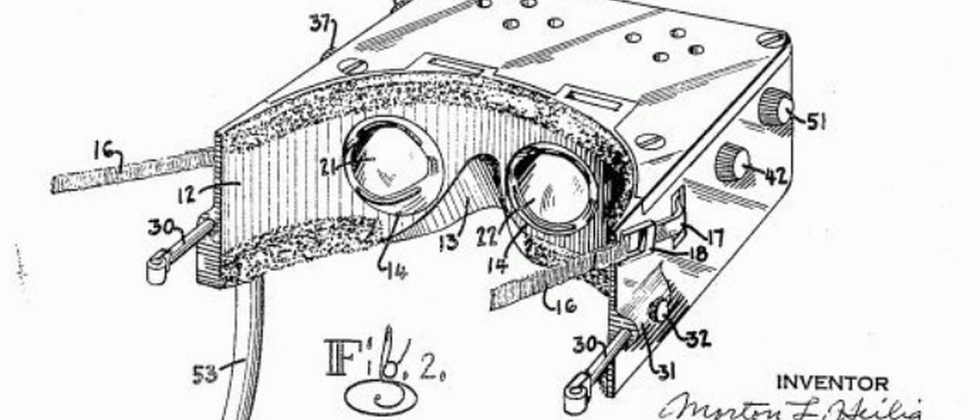Hello, everyone, I'm "Songbao Writing Code".
Recently, I brought you a "VR field" to share, the main outline is as follows:
History of VR Development - Introduction to VR Technology - VR Industry Data - Future Development Route of VR - Learn more about VR
Today we bring the history of VR development , welcome to pay attention, leave a message to exchange and learn.
History of VR
1930s science fiction
In the 1930s, writer Stanley mentioned such a kind of virtual reality glasses in his novel "Pygmalion's Glasses", when people wear it, they can see, hear and smell the characters inside. The things that are felt are like real life in them.
1950s-1960s
Early researchIn the mid-1950s, American photographer Morton Heilig invented the first VR device: Sensorama (patent filed in 1962). It's huge (pictured below), with a fixed screen, 3D stereo, 3D display, vibrating seat, fan (simulating wind blowing), and a scent generator.
In 1960, Morton Heilig filed a patent document for a more ingeniously designed VR glasses. In appearance, the design of this VR device is very similar to modern VR glasses. However, it only has a stereoscopic display function and does not have a posture tracking function.
In 1968, American computer scientist Ivan Sutherland invented the VR/AR glasses prototype that is closest to the concept of modern VR equipment. Because of its heavy weight, it needs to be hung on the top of the person's head by a pair of mechanical arms, so it is dubbed "Damocles". Sword".
This VR glasses realizes the preliminary posture detection function through ultrasound + mechanical axis.
1990s
The first VR craze came in the 1990s, and with the boom in the market, VR glasses ushered in the first craze.
Above, quoted from an article by Scott Stein on VR. The magazine on the left is "Technology New Life" in June 1993, and the magazine on the right is "Time Magazine" on August 17, 2015.
The productization of this high-tech toy has aroused great interest in the media and industry, and major game console companies regard it as a transformative opportunity for the game industry, and are scrambling to launch their own VR glasses products:
Although the appearance of the above products is no different from the VR we see today, the display technology, 3D rendering technology and motion detection technology in the 1990s are not mature. The viewing experience falls far short of "usable" standards.
For example, the more famous Virtual Boy (produced by Nintendo) only supports red and black two-color display, and the single-eye resolution is only 384x224, which is very grainy.
After these VR products were launched, they were criticized by players. Manufacturers have also recognized the huge barrier between ideal and reality, and they have all stopped and waited for the further development of technology.
2012 VR boom restarts
In 2012, the Oculus Rift came out, a VR glasses device that raised $2.5 million on Kickstarter, which brought people's vision back to the realm of VR.
The founder Palmer himself is a VR network controller. He has used all kinds of VR in the last century, and the experience is not satisfactory, so he decided to do it himself, so he has the Oculus Rift.
Facebook announced in July 2014 that it was acquiring Oculus for $2 billion. A new round of VR development has begun.
Technology Hype Cycle
Seeing this, you may feel that the development of VR technology is very ups and downs. But in fact, most new technologies will go through a stage of ups and downs from the conception to the final popularization. Moreover, the industry has a curve that specifically describes this process, called The Hype Cycle.
The horizontal axis of the curve is the maturity of the technology over time, and the vertical axis is the technology exposure/industry attention.
It can be seen from the curve that in the development process of a new technology, there will be such a law:
Technology Trigger : New technologies are proposed and gradually enter the public's field of vision, and prototype products are constantly being developed, which stimulates the curiosity of the public.
Peak of Inflated Expectations : Mass companies/research institutes begin to rush into new fields, intending to seize new growth points and take the lead. During this period, people tend to ignore the shortcomings of new technologies and blindly invest human and material resources. At the same time, in media publicity, they will also be blindly optimistic, cater to the interests of the public, and overly publicize the bright prospects of new technologies.
Trough of Disillusionment : When batches of products are developed and put into the market in a hurry, people finally find that the so-called "bright future" is far from coming, and various negative evaluations follow one after another. , the company finally recognized the reality and began to tighten investment, and the entire market gradually cooled down.
Slope of Enlightenment : Based on the lessons learned from the failure of the first wave of products, people began to slowly improve the new technology, gradually improving the effect.
Stable production (Plateau of Productivity) : When the performance/effect of the new technology can finally meet the demand, it will enter the stage of substantial popularization of production.
In the history of VR development, it just corresponds to the previous decades. The boom of the 1990s was a peak of high expectations, and after a round of troughs, we have entered a bright period of steady climb.
About "Songbao Write Code"
One sentence introduction: Songbao writes more than code.
Tags: more than just code depth and field of vision, byte classmates
Introduction: Songbao writes more than code, the nickname of saucxs, the author of watermark-dom watermark open source 900+Star, a former ACM school team, and now a byte engineer. He likes to challenge himself, serving as an interviewer and school recruiting programming questions. A blogger with "value to help you".
Personal Github address: https://github.com/saucxs









**粗体** _斜体_ [链接](http://example.com) `代码` - 列表 > 引用。你还可以使用@来通知其他用户。